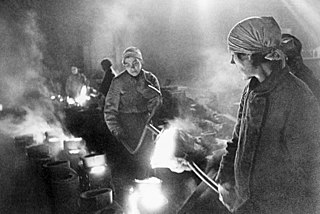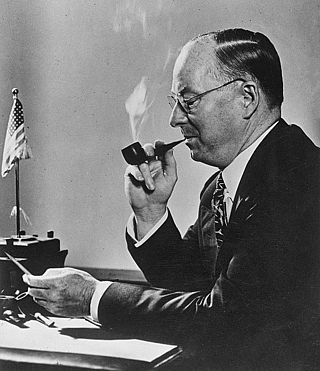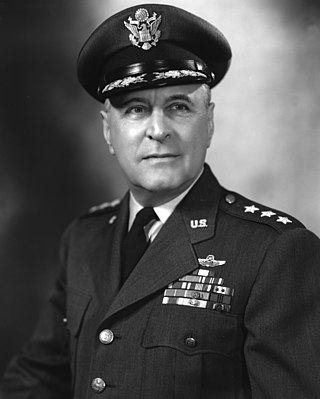
The Joint Chiefs of Staff (JCS) is the body of the most senior uniformed leaders within the United States Department of Defense, which advises the president of the United States, the secretary of defense, the Homeland Security Council and the National Security Council on military matters. The composition of the Joint Chiefs of Staff is defined by statute and consists of a chairman (CJCS), a vice chairman (VJCS), the chiefs of the Army, Marine Corps, Navy, Air Force, Space Force, and the chief of the National Guard Bureau. Each of the individual service chiefs, outside their JCS obligations, works directly under the secretaries of their respective military departments, e.g. the secretary of the Army, the secretary of the Navy, and the secretary of the Air Force.
Europe first, also known as Germany first, was the key element of the grand strategy agreed upon by the United States and the United Kingdom during World War II after the United States joined the war in December 1941. According to this policy, the United States and the United Kingdom would use the preponderance of their resources to subdue Nazi Germany in Europe first. Simultaneously, they would fight a holding action against Japan in the Pacific, using fewer resources. After the defeat of Germany—considered the greatest threat to the UK and the Soviet Union—all Allied forces could be concentrated against Japan.

The Combined Chiefs of Staff (CCS) was the supreme military staff for the United States and Britain during World War II. It set all the major policy decisions for the two nations, subject to the approvals of British Prime Minister Winston Churchill and U.S. President Franklin D. Roosevelt.
The United States maintained its Constitutional Republic government structure throughout World War II. Certain expediencies were taken within the existing structure of the Federal government, such as conscription and other violations of civil liberties, including the internment and later dispersal of Japanese-Americans. Still, elections were held as scheduled in 1944.

Military production during World War II was the production or mobilization of arms, ammunition, personnel and financing by the belligerents of the war, from the occupation of Austria in early 1938 to the surrender and occupation of Japan in late 1945.

The War Shipping Administration (WSA) was a World War II emergency war agency of the US government, tasked to purchase and operate the civilian shipping tonnage the United States needed for fighting the war. Both shipbuilding under the Maritime Commission and ship allocation under the WSA to Army, Navy or civilian needs were closely coordinated though Vice Admiral Emory S. Land who continued as head of the Maritime Commission while also heading the WSA.

The War Production Board (WPB) was an agency of the United States government that supervised war production during World War II. President Franklin D. Roosevelt established it in January 1942, with Executive Order 9024. The WPB replaced the Supply Priorities and Allocations Board and the Office of Production Management.
The First Washington Conference, also known as the Arcadia Conference, was held in Washington, D.C., from December 22, 1941, to January 14, 1942. President Roosevelt of the United States and Prime Minister Churchill of the United Kingdom attended the conference, where they discussed a future United Nations.
The National Security Resources Board was a United States government agency created by the National Security Act of 1947 whose purpose was to advise the President, in times of war, on how to mobilize natural resources, manpower, and the scientific establishment to meet the demands of the Department of Defense.

The Army Service Forces was one of the three autonomous components of the United States Army during World War II, the others being the Army Air Forces and Army Ground Forces, created on 9 March 1942. By dividing the Army into three large commands, the Chief of Staff, General George C. Marshall, drastically reduced the number of officers and agencies reporting directly to him. The Army Service Forces brought together elements of five different components of the Army: elements of the War Department General Staff (WDGS), especially its G-4 division ; the Office of the Under Secretary of War; the eight administrative bureaus; the nine corps areas, which became service commands; and the six supply arms and services, which became known as the technical services. The Army Service Forces was initially known as the United States Army Services of Supply but the name was changed on 12 March 1943, as it was felt that the term "supply" did not accurately describe the broad range of its activities. The Army Service Forces was abolished on 11 June 1946 and most of its functions were taken over by the War Department General Staff.

Donald Marr Nelson (1888–1959) was an American business executive and public servant, serving as the executive vice president of Sears Roebuck before accepting the position of director of priorities of the United States Office of Production Management (1941–1942). In 1942 Nelson became chairman of the War Production Board (1942–1944) when it replaced the OPM. He later served for two years (1945–1947) as president of the Society of Independent Motion Picture Producers.

The United States Army Air Forces was the major land-based aerial warfare service component of the United States Army and de facto aerial warfare service branch of the United States during and immediately after World War II (1941–1947). It was created on 20 June 1941 as successor to the previous United States Army Air Corps and is the direct predecessor of the United States Air Force, today one of the six armed forces of the United States. The AAF was a component of the United States Army, which on 2 March 1942 was divided functionally by executive order into three autonomous forces: the Army Ground Forces, the United States Army Services of Supply, and the Army Air Forces. Each of these forces had a commanding general who reported directly to the Army Chief of Staff.

The Air War Plans Division (AWPD) was an American military organization established to make long-term plans for war. Headed by Harold L. George, the unit was tasked in July 1941 to provide President Franklin D. Roosevelt with "overall production requirements required to defeat our potential enemies." The plans that were made at the AWPD eventually proved significant in the defeat of Nazi Germany.

The War Food Administration was a United States government agency that existed from 1943 to 1945. The War Food Administration was responsible for the production and distribution of food to meet war and essential civilian needs during World War II. It was a predecessor of the Farm Service Agency.
The Combined Food Board was a temporary World War II government agency that allocated the combined economic resources of the United States and the United Kingdom. It was set up by President Franklin D. Roosevelt and Prime Minister Winston Churchill on June 9, 1942. Canada, after insisting on its economic importance, was given a place on the board in November, 1942. At first the Board was a pawn in a battle between the U.S. Department of Agriculture and the U.S. War Food Administration. After that was resolved, the Board ran smoothly, and effectiveness increased. Its major achievement was the multi-nation commodity committees that it set up in 1945, which became the International Emergency Food Council. It tried to organize responses to a massive shortage of food in war-torn areas. It closed in 1946.
The Combined Raw Materials Board was a temporary World War II government agency that allocated the combined economic resources of the United States and Britain. It was set up by President Franklin D. Roosevelt and Prime Minister Winston Churchill on January 26, 1942. Later Canada participated as an associated member in many of the Board's decisions.

The Combined Munitions Assignments Board was a major government agency for the U.S. and Britain in World War II. With Harry Hopkins, Roosevelt's top advisor in charge, it took control of the allocation of war supplies and Lend lease aid to the Allies, especially Britain and the Soviet Union.
The Combined Shipping Adjustment Board or Combined Shipping Board was a joint American-British war agency 1942-45 nominally in charge of commercial shipping. It proved ineffective as much more powerful boards, such as the Combined Munitions Assignments Board, ignored it. The U.S. Army and Navy controlled most shipping and refused to share responsibility with the Board as did the powerful War Shipping Administration. For practical purposes the agency was inactive by spring 1943.

The third presidential term of Franklin D. Roosevelt began on January 20, 1941, when he was once again inaugurated as the 32nd president of the United States, and the fourth term of his presidency ended with his death on April 12, 1945. Roosevelt won a third term by defeating Republican nominee Wendell Willkie in the 1940 United States presidential election. He remains the only president to serve for more than two terms. Unlike his first two terms, Roosevelt's third and fourth terms were dominated by foreign policy concerns, as the United States became involved in World War II in December 1941.

United States war plans for a conflict with the Soviet Union (USSR) were formulated and revised on a regular basis between 1945 and 1950. Although most were discarded as impractical, they nonetheless would have served as the basis for action had a conflict occurred. At no point was it considered likely that the Soviet Union or United States would resort to war, only that one could potentially occur as a result of a miscalculation. Planning was conducted by agencies of the Joint Chiefs of Staff, in collaboration with planners from the United Kingdom and Canada.